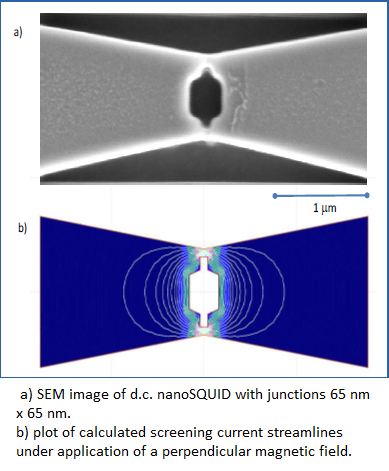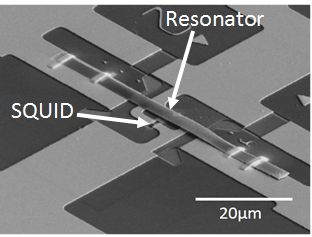We are helping to develop quantum sensors to enable single quantum particle detection (including electronic spins, single photon spectroscopy, and ultimately single phonons), as well atomic scale mass sensing, femtometre displacement and sub-piconewton forces.
The requirements of quantum metrology and nanoscience are driving the need for single particle detection and measurement capability across a wide range of physics, including quantum information processes (QIP), single photon detection, single spin sensing and nanoelectro-mechanical resonator system (NEMS).
Nanoscale superconducting quantum interference devices, known as 'nanoSQUIDs', represent a new manifestation of an old, but exciting, superconducting technology. It is well known that limitations on SQUID sensitivity set by thermal noise can be reduced by lowering the inductance and capacitance of the SQUID device. NPL has pioneered the move to nanoscale SQUIDs by minimising both the size of the SQUID superconducting loop and the capacitance of the Josephson junctions, through the use of microbridge technology rather than tunnel junctions. State-of-art nanoSQUID performance has been achieved at NPL with operating temperature above 4.2K. These high performance devices and the fabrication technologies on which they are based are being applied in a number of projects.
Tunable and scalable superconducting junctions have great potential for future applications in smart sensing and for quantum technologies. Josephson junctions and SQUIDs made with graphene as the barrier have unique bipolar supercurrents, tunable by gate voltage. We have fabricated graphene Josephson junctions and SQUIDs using CVD graphene, demonstrating that graphene Josephson junctions with Nb electrodes can work effectively without any thermal hysteresis from 1.5 K down to a base temperature of 320 mK.
Inductive microwave readout techniques are also being applied to this nanoSQUID technology to improve the sensitivity of the quantum metrological system further, towards the uncertainty principle limit.

At NPL, we have used an ultralow noise nanoSQUID to measure the hysteretic magnetisation behaviour of a single FePt nanobead at a temperature of around 7 K in a magnetic field of only10 mT. We also shown that, using nanomanipulation, the nanobead can be accurately positioned with respect to the SQUID loop and then removed without affecting SQUID performance.
Detection of ever smaller magnetic particles is of crucial technological and scientific importance, driven both by the needs of the information technology and telecom communities but also by medical and biological requirements, in addition to improved understanding of the physics of small numbers of coupled spins. We believe that the sensitivity of our existing nanoSQUIDs is good enough to detect a single electronic spin flip. We are working with Surrey University, exploiting their deterministic single ion implanter capability, to address this challenge. Spin-based QIP applications may be expected to follow.
The same Josephson junction technology is being employed in the development of novel inductive superconducting transition edge detectors (ISTED) for single photon and massive particle measurements and spectroscopy.
We have demonstrated single visible photon spectroscopy (with energy resolution of 0.2eV) at an operating temperature of 6.8K. In addition to potential quantum communications applications this same technology has potential uses for improved X-ray and massive particle physics and medical metrology.
An ISTED bolometer can be used to measure directly the energy deposited by single ionising radiation events. This work involves collaboration between the Quantum Detection Group and Radiation Dosimetry Group at NPL, together with Surrey University and the Royal Surrey County Hospital.
Nanoelectromechanical sensors (NEMS) are of growing importance for quantum sensing. By reducing the scale of the mechanical sensor to sub-micrometre its resonant frequency is pushed towards the microwave region, while its mass is driven down to very small values. Both of these assist in improving the sensitivity of NEMS detectors. We are working on the use of near-field microwave techniques to excite and readout NEMS sensors and we use novel techniques borrowed from quantum optics, such as side-band cooling, to further improve sensitivity and reduce noise.
 Our aim is the development of NEMS-based nanosensors with multi-property metrology capability, leading in the longer term to quantum measurement. Our novel approach is to develop two methods, including excitation, detection and sideband cooling of cantilever-style NEMS resonators.
Our aim is the development of NEMS-based nanosensors with multi-property metrology capability, leading in the longer term to quantum measurement. Our novel approach is to develop two methods, including excitation, detection and sideband cooling of cantilever-style NEMS resonators.
The first of these involves near-field microwave resonator with strongly localised coupling to the mechanical resonator, allowing non-equilibrium manipulation of the coupled system. We have already demonstrated 'side-band cooling' of a mechanical resonator (analogous to laser cooling of an atom) using a near-field microwave resonator and are developing novel pulsed techniques to exploit the measurement capabilities of this new technique.
The second method is applicable at cryogenic temperatures, using a nanoSQUID (Superconducting Quantum Interference Device) as a sensitive readout of the tiny displacement of a NEMS resonator in the high frequency regime (up to 1 GHz). NPL's development of very low-noise nanoSQUIDs using focussed ion beam techniques has enabled a good match between nanomechanical resonators and the readout system.
We are developing both top-down and bottom up nanofabricated mechanical resonators, in 1D and 2D, using a variety of materials including high stress Si3N4, carbon nanotubes, graphene and other 2D materials.
We are developing several other novel sensor types, based on the high quality factors achievable with dielectric microwave resonators and the fact that frequency is the most accurately measurable physical parameter. These sensors include a cryogenic bolometer using coupled resonance between a stable sapphire resonator and a strongly temperature dependent perovskite material. Also near field microwave resonators are used in an accelerometer demonstrator. The non-contacting open resonator method used for graphene and other thin film measurements is based on this generic method as well.
Our research and measurement solutions support innovation and product development. We work with companies to deliver business advantage and commercial success.
Contact our Customer Services team on +44 20 8943 7070